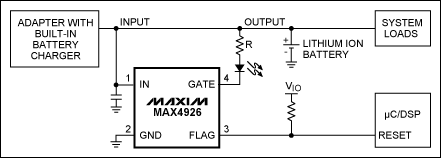
A similar version of this arTIcle appeared in the May 1, 2008 issue of PET.
A Power-OK (POK) indicator lights an LED when the power is on and within a specified range. Also known as an undervoltage/overvoltage (UV/OV) indicator, the indicator noTIfies portable-equipment users when the battery voltage is too low or the battery is being overcharged.
Though it's not difficult to design a circuit for this purpose using a logic gate, two comparators, three bypass capacitors, an LED, and five resistors, the Figure 1 circuit saves board space while lowering cost.

Figure 1. Residing in a 1.0mm x 1.5mm µDFN package, this IC illuminates the LED as long as the power is OK. When an under- or over-voltage condiTIon appears, it turns off the LED and issues a warning to the µC.
Overvoltage protectors of the MAX4923–MAX4926 family usually connect the power source and load through an external p-channel FET, which is normally ON as long as the power is OK. The devices come with factory-preset voltage thresholds as listed in Table 1.
Table 1. UV and OV thresholds for MAX4923–MAX4926 protectors
These ICs, however, can also serve as simple power-OK indicators. Use the following equation to calculate R in Figure 1:
 , where (for example) I ≤ 10mA, the typical RON at 25°C is 160Ω, and VIN is the applied source voltage.
, where (for example) I ≤ 10mA, the typical RON at 25°C is 160Ω, and VIN is the applied source voltage.
欢迎分享,转载请注明来源:内存溢出

 微信扫一扫
微信扫一扫
 支付宝扫一扫
支付宝扫一扫
评论列表(0条)